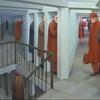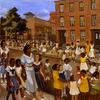
Funerary Portraits from Roman Egypt: Facing Forward
Come face to face with portraits of Egyptians who lived during the Roman period and discover what role these images played in funerary rituals as well as what modern technical study can reveal about ancient artistic practices.
Featuring several painted portrait panels, sculptural portraits, and a linen burial shroud, this tightly focused exhibition asks visitors to reflect upon objects that represent the deceased and were once intimately connected with their bodies. The exact findspots and details of the excavation and dismantling of these objects were not recorded; and while the portraits present seemingly familiar faces, we can never fully know the people behind them. So what more can we learn from the objects themselves?
The exhibition foregrounds scientific analysis and technical research conducted by staff in the Harvard Art Museums’ Straus Center for Conservation and Technical Studies. Their work, part of an international research project, helps illuminate how ancient artists created these painted and plaster faces. In-gallery displays of technical images of the objects, samples of artists’ materials such as pigments and binding media, and a sequence of panels illustrating painting techniques provide further context. In recovering the artistic processes, the complicated histories of these objects have also come into view.
The individuals depicted in these portraits lived in the first three centuries CE, when Egypt was a province of the Roman empire, and their burial treatments attest to the multicultural nature of that era. Their bodies were mummified in the Egyptian tradition, but their portraits appear in a Graeco-Roman style. They wore clothes, jewelry, and hairstyles that were popular in Rome, while also participating in Egyptian religious institutions. The funerary traditions represented by the objects in this exhibition were elaborate and expensive, privileges of an elite class who could choose how their bodies were treated in death.
- Contact:
- Krystle Brown
- Krystle_Brown@harvard.edu
- (617)-495-9295













100x100_c.jpg)

